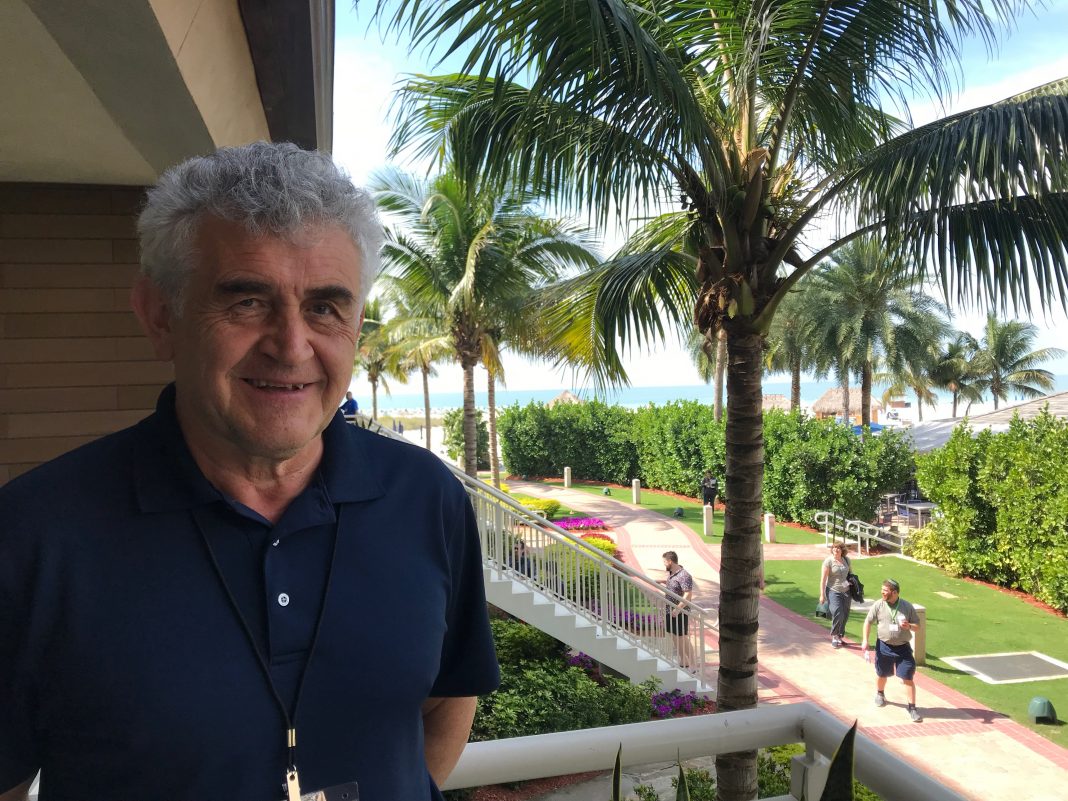.
S O U R C E : Genengnews

Rade Drmanac capped off the 2020 AGBT by unveiling a new instrument and antibody-based chemistry that, for some users, can yield a $100 human genome sequence.
Marco Island, FL—The coveted last slot of this year’s AGBT conference*, the premier genomics conference held in Florida every winter, promised to be a blockbuster with the title “First $100 genome sequencing enabled by new extreme throughput DNBSEQ platform.” The nearly 1,000 scientists in attendance did not leave disappointed.
Radoje (Rade) Drmanac, PhD, CSO of MGI, was a co-founder of Complete Genomics, which briefly enjoyed the limelight in the world of next-gen sequencing when it launched in 2008 with its novel DNA NanoBalls (DNB) platform. But the company struggled after going public and was acquired by BGI for about $117 million in 2013. MGI, the company’s next-gen subsidiary, has been growing in China and Europe but has not released in the U.S. until now.
The promise of a $100 genome, which has been tossed around for a while, is “a great achievement” Drmanac told GEN on the eve of his presentation. Because his personal goal is to sequence “as many genomes as possible,” it follows suit that they have to be affordable. Last year at AGBT, MGI introduced the T7 platform, which is currently providing genomes at roughly $500 each.
But what a difference a year makes. MGI says the combination of its new Tx platform and new chemistry means they can lower the consumables cost five-fold to $100 per genome.
“We haven’t heard an announcement of this scale at AGBT for a long time,” says Yaniv Erlich, PhD, CSO of MyHeritage.
In his AGBT talk, Drmanac presented details of MGI’s new Tx sequencing platform and the new CoolMPS chemistry. The DNBSEQ sequencing instruments and reagent kits will be made available in the United States starting in April 2020.
The improvements here are “not going from bad to good,” Drmanac explains, rather they are “going from excellent to extremely excellent.” MGI reports on average one error in 170 kilobases of sequenced DNA. Usually, Drmanac says, users are happy with about one error in one thousand.
Spot the difference
MGI’s DNBseq technology combines DNBs—small, densely packed balls of DNA generated by rolling circle replication—and a patterned array of “sticky spots” to capture the DNBs. Rather than the T7’s seven billion “sticky spots” to capture DNBs, the DNBseq-Tx has 70 billion. The spots are twice as dense on the new Tx instrument—located only 500 nM apart—which results in twice the number of nanoballs in the same area.
With a surface that is five times larger and a doubling of the number of spots, more genomes can be sequenced on each run. Indeed, the Tx can sequence up to 700 genomes on a single run, a capacity that is an order of magnitude larger than any sequencer on the market today. It takes a full capacity run of 700 genomes to achieve the $100 price point.
Also notable is the new fluidics system designed to handle the big arrays in the Tx. Rather than a flow cell, where the solutions wash over the samples, a robot dips a large panel through a series of solutions, conserving reagents and cutting cost.
In a sense, MGI has “created a deconstructed sequencer,” notes Keith Robison, PhD, a leading genomics blogger and authority on next-gen sequencing platforms. Rather than trying to integrate different fluids and imaging around the flowcells, MGI has given each stage of the process “its own little station, with four arms choreographed to shuttle each wafer through the cycle of stages.”
Robison adds: “MGI has taken a really out-of-the-box approach to drive the per genome cost down for a large project—eliminating fluidics and instead dipping huge slides in reagents.” The new platform is “unlikely to influence the pattern of sequencer design” but he says it’s “a clever way to minimize the waste of expensive reagents.”
A “magical new tool”
CoolMPS (MPS stands for massively parallel sequencing) is the first nucleobase-specific antibody-based sequencing chemistry. Drmanac tells GEN that MGI wanted to avoid the DNA “scars” that can accumulate with traditional sequencing methods that use dye-labeled reversibly terminated nucleotides (RTs) and affect the accuracy of subsequent reads.
The CoolMPS chemistry introduces unlabeled RTs and four natural nucleobase-specific fluorescently labeled antibodies in its sequencing process to recognize the incorporated bases. In this process, the natural scarless bases are added in each sequencing cycle. This enables greater accuracy and longer reads, according to Drmanac, with a signal that is three times brighter than MGI’s standard chemistry. Further details on the CoolMPS chemistry can be found in a bioRxiv preprint posted by Drmanac’s team last week.
What made Drmanac think of using an antibody? “It just hit me, like, why in the world are we trying to do this indirectly when antibodies can recognize the base?” he says. MGI attaches the dye on the antibody (the amines are labeled) and the antibodies recognize the nucleotides. They need no linkers and there is no dye when the nucleotides are being incorporated. Drmanac says that it is very cheap, highly specific and there is no cross talk. Not doing this earlier, he explains, was “a simple mental block in our inventions.”
.../...
.










































